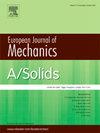Dynamic uncertainty analysis of rod-fastening rotor systems with rubbing effects using a Chebyshev interval method
IF 4.4
2区 工程技术
Q1 MECHANICS
引用次数: 0
Abstract
The study investigates the uncertainty quantification and parameter influence of a rod-fastening combined rotor system considering rub-impact effects. A continuous-discrete coupled dynamic model incorporating rub-impact boundaries is formulated based on the Lagrange equation, and the strongly nonlinear dynamic response is solved using the Newmark-β numerical method. An interval propagation analytical framework based on Chebyshev polynomial expansion is proposed to establish an efficient parameter uncertainty quantification system. The accuracy of the model and interval algorithm is validated through experiments and Monte Carlo simulations. The results demonstrate that the Chebyshev interval algorithm effectively characterizes parameter uncertainty, significantly reduces the computational complexity of nonlinear analysis, and enables rapid estimation of the rotor system's interval response. Interval analysis reveals the mapping relationship between rub-impact parameters and nonlinear vibration characteristics. A parameter classification criterion is established based on the difference in influence pathways: Direct Response-Influencing Parameters (DRIP) and Natural Frequency-Influencing Parameters (NFIP). Numerical experiments indicate that NFIP parameters influence vibration characteristics indirectly by altering the system's natural frequency, whereas DRIP parameters directly affect the dynamic response. The parameter sensitivity index of rub-impact clearance is considerably greater than that of contact stiffness and friction coefficient, and rub-impact fault-related uncertainties exert a notable influence only within the rub-impact domain. The proposed quantification framework provides a quantitative engineering criterion for predicting rub-impact fault thresholds and tolerance band design in aero-engine rotor systems.
用切比雪夫区间法分析具有摩擦效应的杆系转子系统的动态不确定性
研究了考虑碰摩效应的连杆紧固组合转子系统的不确定性量化及参数影响。基于拉格朗日方程建立了含碰摩边界的连续离散耦合动力模型,采用Newmark-β数值方法求解了强非线性动力响应。提出了基于切比雪夫多项式展开的区间传播分析框架,建立了有效的参数不确定性量化系统。通过实验和蒙特卡罗仿真验证了模型和区间算法的准确性。结果表明,切比雪夫区间算法能有效表征参数的不确定性,显著降低非线性分析的计算复杂度,能够快速估计转子系统的区间响应。区间分析揭示了碰摩参数与非线性振动特性之间的映射关系。根据影响途径的不同,建立了直接响应影响参数(Direct response - influence Parameters, DRIP)和固有频率影响参数(Natural frequency - influence Parameters, NFIP)的参数分类准则。数值实验表明,NFIP参数通过改变系统固有频率间接影响振动特性,而DRIP参数直接影响系统的动态响应。碰触间隙的参数敏感性指数明显大于接触刚度和摩擦系数,碰触故障相关不确定性仅在碰触域内有显著影响。所提出的量化框架为预测航空发动机转子系统碰摩故障阈值和公差带设计提供了定量工程准则。
本文章由计算机程序翻译,如有差异,请以英文原文为准。
求助全文
约1分钟内获得全文
求助全文
来源期刊
CiteScore
7.00
自引率
7.30%
发文量
275
审稿时长
48 days
期刊介绍:
The European Journal of Mechanics endash; A/Solids continues to publish articles in English in all areas of Solid Mechanics from the physical and mathematical basis to materials engineering, technological applications and methods of modern computational mechanics, both pure and applied research.

 求助内容:
求助内容: 应助结果提醒方式:
应助结果提醒方式:


